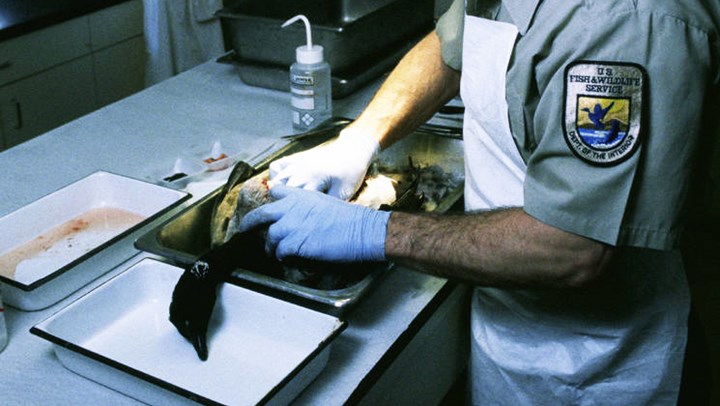
by Jonathan Mawdsley, Science Coordinator, Association of Fish and Wildlife Agencies - Monday, April 3, 2017

On the last full day of the Obama administration, outgoing Director of the U.S. Fish and Wildlife Service (USFWS) Dan Ashe provided hunters and anglers with an unpleasant surprise by issuing a “Director’s Order” decreeing that there would be a total ban on lead ammunition and lead fishing tackle on all USFWS lands within five years. This order was issued without any discussion or involvement with the nation’s hunters, anglers, sportsmen’s groups or the state agencies that manage many of our nation’s fish and wildlife resources, including legal means and methods of take.
Ryan Zinke, President Trump’s new Secretary of the Interior, took decisive action on his first day in office to reverse this last-minute act by the outgoing Obama administration. The reaction from anti-hunting and animal welfare extremist groups to Secretary Zinke’s reversal of the proposed ban was swift and immediate. They claimed in national media outlets that Secretary Zinke’s actions would poison 130 wildlife species and lead to the deaths of up to 20 million birds every year.
I serve as the staff scientist for the Association of Fish and Wildlife Agencies, the organization that represents our 50 state fish and wildlife agencies in Washington, D. C. At the request of one of our state fish and wildlife agency directors, I was asked to review the science behind these claims and determine whether or not there was any truth to these numbers. I quickly discovered that the anti-hunting groups were misquoting and misusing both the number of species affected by lead, as well as the number of animals dying from lead poisoning in the United States each year.
The first number—130 wildlife species affected by lead poisoning—comes directly from a chapter in a book published by the Peregrine Fund and the United States Geological Survey (USGS) in 2009. The authors of this particular chapter reviewed the scientific literature from 1876 to 2008 and found reports of lead ingestion or lead poisoning in 130 species of animals around the world. Note that this original number includes animals that simply ingested lead, not just the animals that were actually poisoned by lead. Importantly, the book chapter doesn’t tell us how many of these reports were occasional isolated incidents and how many individual animals in each case were actually suffering from lead poisoning. Furthermore, this number includes species worldwide, many of which don’t occur naturally in the United States, much less on USFWS lands. The idea that all of these 130 species would somehow be affected by Secretary Zinke’s actions is simply preposterous.
The second number—up to 20 million birds dying from lead poisoning each year—is even more speculative. This number is based on very preliminary calculations contained in a 2009 opinion piece in the Bulletin of the Wildlife Society, written by researchers at the Missouri Department of Conservation (MDC), the USFWS, and the University of Missouri. These scientists and colleagues studied captive mourning doves and discovered that virtually all of the doves in their studies died after ingesting lead pellets. For this opinion piece, the authors extrapolated from their original findings, combining their own observations on high rates of mortality for doves that ingested lead pellets, other published information about pellet ingestion rates in certain dove populations and total dove population estimates for all of North America. By combining this information, these scientists obtained a figure of some 8.8 to 15 million mourning doves that might be dying every year from ingesting lead pellets.
This is what scientists might call a “seat of the pants” or “back of the envelope” calculation. To be clear, the original paper was published as an opinion piece—not as an original scientific research paper—and the authors included plenty of appropriate qualifying language such as “it may be possible that” and “it appears that” to make it clear they were not definitively stating that 8.8 to 15 million doves were actually being killed. The point of this exercise was not so much to put an exact figure on the number of mourning doves dying each year from lead poisoning, but rather to raise awareness among wildlife managers that lead poisoning could potentially have impacts on mourning dove populations.
In a subsequent publication, another team of scientists (including the lead author of the 2008 opinion piece) actually emphasized the large degree of uncertainty around any estimates of total mourning dove mortality from lead ingestion, stating very clearly that “the magnitude of lead exposure and poisoning in mourning doves is unknown.” Claims that as many as 20 million wild birds are actually dying each year in the United States from lead poisoning simply are not supported by the available scientific evidence.
Science, along with hunting and fishing, is an important cornerstone of the North American Model of Fish and Wildlife Conservation. Our public state and federal fish and wildlife agencies are tasked with managing fish and wildlife populations in a manner consistent with the best available science. We must be vigilant in ensuring that scientific information is not quoted out of context by those who would seek to curtail our rights to enjoy activities such as hunting and fishing, which are clearly consistent with the principles of sound, scientifically-based fish and wildlife management.
■ ■ ■
Editor's Note: It’s time to expose the anti-hunters’ and liberal media’s misuse of scientific data by sharing this story link with fellow hunters and non-hunters alike. For more information on Secretary Zinke and his overturning of the Obama Administration’s lead ammo ban, check out the following links:
E-mail your comments/questions about this site to:
[email protected]
